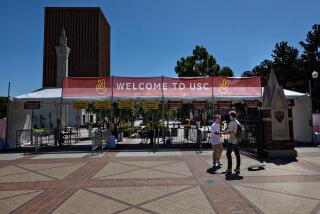‘Choice’ Plan in Public Schools Considered : Education: Bill allows students to transfer to another district under certain conditions. Experts do not expect many such switches to take place.
SACRAMENTO — A limited plan allowing pupils to cross district lines to attend public schools of their choice is part of the complicated budget negotiations under way between Gov. Pete Wilson and the Legislature.
The proposal, developed by Assemblyman Charles W. Quackenbush (R-Saratoga) and revised by the governor’s office in recent days, would allow students to transfer into districts that are willing to accept them, but only under certain conditions.
Bill Livingstone, Wilson’s press secretary, confirmed that legislation to implement the plan is included in the package of budget-related bills. It will be voted on separately from the overall budget bill, which was approved Thursday by the Assembly.
Maureen DiMarco, Wilson’s secretary of child development and education, said the governor “supports carefully constructed experiments in choice,” including this one.
The plan would allow parents unhappy with their neighborhood schools to send their children elsewhere, if they can afford to transport them and if the students meet other requirements. The proposal includes no money to bus children from one district to another.
Furthermore, pupils could not transfer if the move would have a negative effect on either court-ordered or voluntary school desegregation plans. Districts that receive students will have to elect to participate. Those that choose to do so would select transferring students by a lottery, to avoid one district “skimming” the best athletes or students from another.
Only public schools would be included, Quackenbush said. This would not be a “voucher plan,” with state payments to parents who wish to send their children to private schools. However, state payments given on a per-pupil basis--the basic funding for all public schools--would follow the youngster from the old school to the new one, as would special federal funds.
Because of the restrictions, education officials do not expect large numbers of pupils to transfer if the plan is approved.
National experience with “choice” plans suggests that less than 10% of the enrollment will take advantage of the opportunity, state Department of Education officials said.
If few California pupils choose to transfer under such a plan, that would be just as well, said a department official who asked not to be identified.
“No one has spent a minute thinking out the logistics of this,” the official said. “Nobody has a clue about how to track kids, how to make sure the money follows the child, how to handle special education kids and a lot of other things.”
The proposal is supported not only by Wilson but by State Supt. of Public Instruction Bill Honig, by members of both parties in both houses and by several education groups. However, the California Teachers Assn. is strongly opposed.
“We support the idea of limited choice within public schools,” Honig said. “If there is available space and a quality education, we shouldn’t hold the family back.
“If you offer people a choice, even if they don’t take advantage of it, they feel they have participated more in their childrens’ education.”
Honig said such a plan also “could be a safety valve--an option for parents if the school gets too bad.”
CTA spokeswoman Tommye Hutto said: “There isn’t any proof that ‘choice’ improves student performances or dropout rates or anything else. It is a lot more political than educational.”
Hutto said the teachers’ union agrees that relatively few students would take advantage of the program but added that “it’s a foot in the door” for a possible later private school voucher plan.
Ron Prescott, Sacramento representative for the Los Angeles Unified School District, said the policy would not have much effect on Los Angeles because the district is carrying out a voluntary desegregation plan that requires schools to maintain as much racial balance as possible.
In those circumstances, Prescott said, few Anglo pupils would be permitted to transfer to other school districts. He added: “If you don’t provide transportation, you don’t really have anything. If you’re going to have minority kids, you’re going to have to provide transportation.”
Under state law, Los Angeles already has interdistrict transfer agreements with many of its neighbors, district officials said.
Last year, 3,326 Los Angeles pupils transferred out, while 1,383 youngsters from other districts chose Los Angeles schools, many of them to take advantage of special magnet programs. Another 1,000 or so Los Angeles pupils took advantage of a new state law that allows parents to enroll their children near their workplaces.
More to Read
Sign up for Essential California
The most important California stories and recommendations in your inbox every morning.
You may occasionally receive promotional content from the Los Angeles Times.










